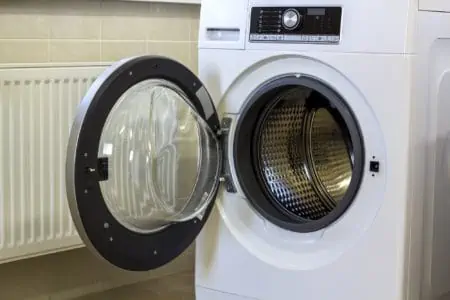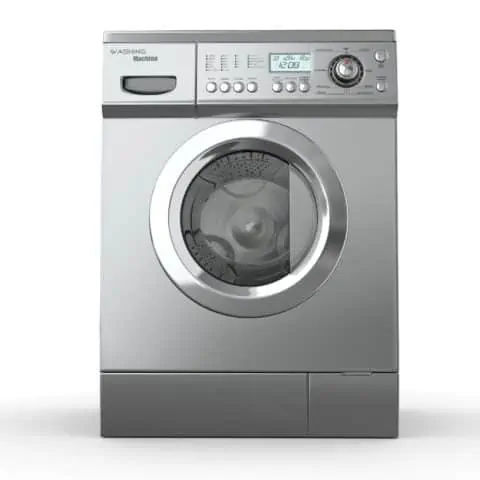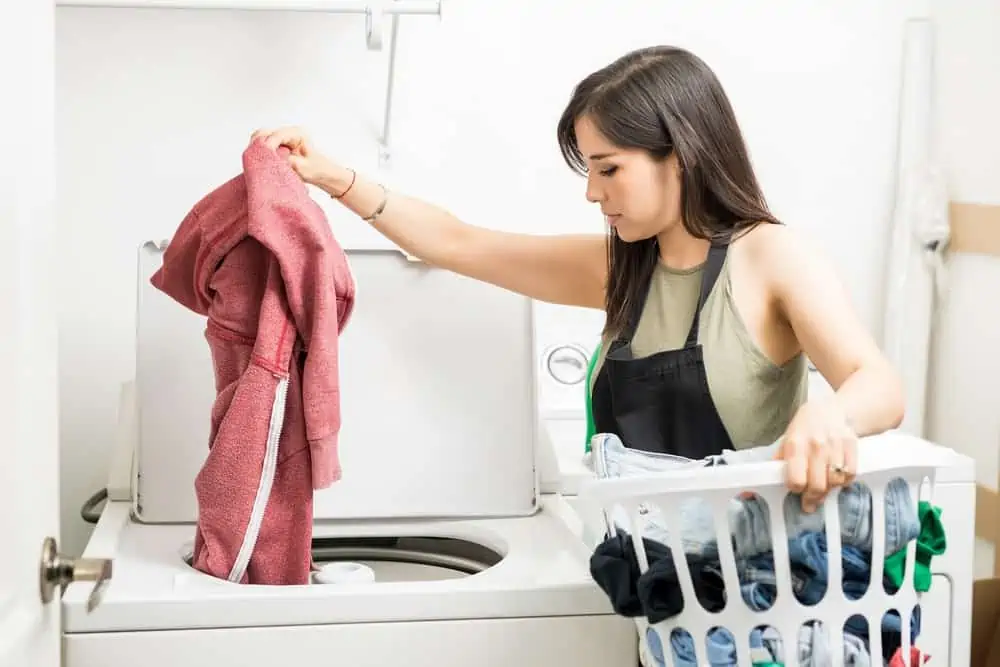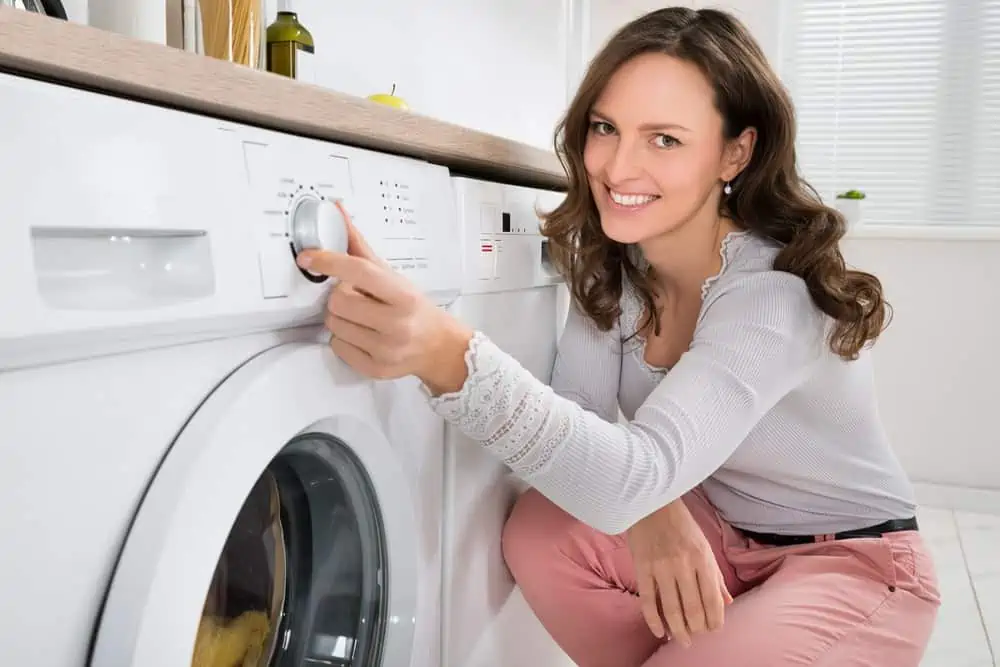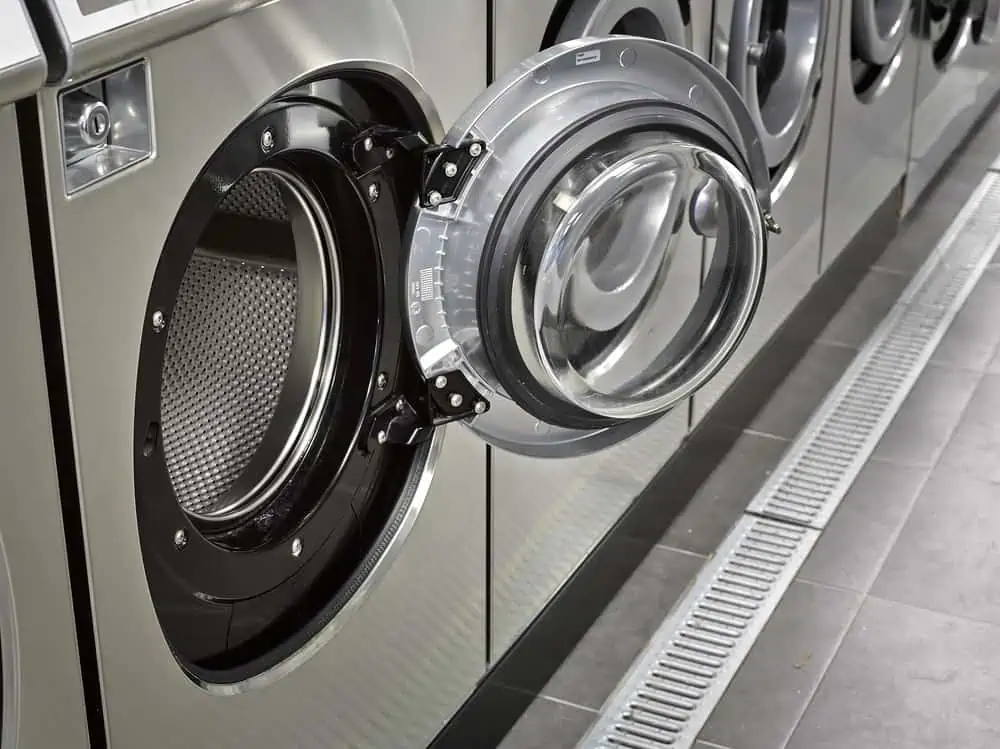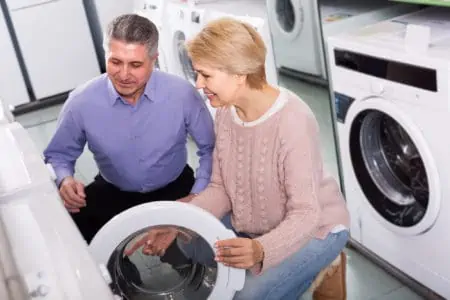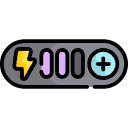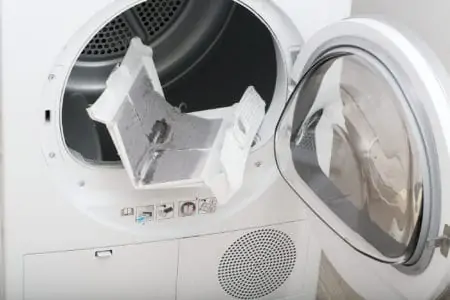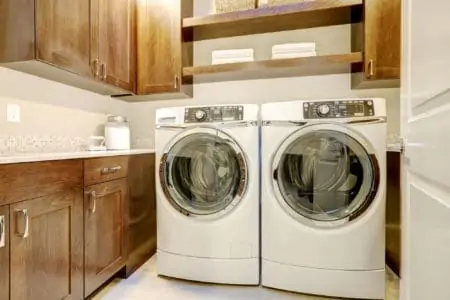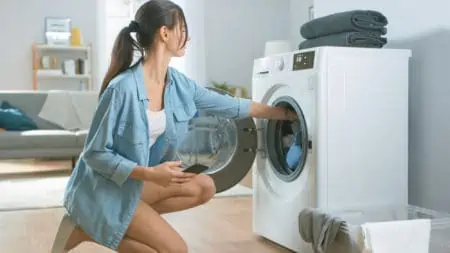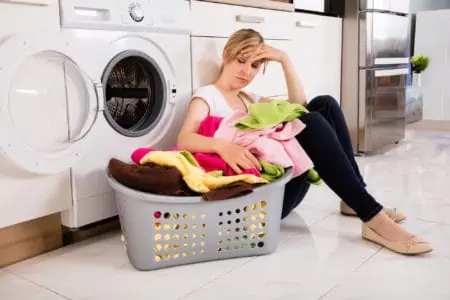If you’re looking for a washing machine, you know it’s overwhelming. There are front load machines, stackable machines, top load washers, and so on. How are you to determine the best type or size of washing machine for you to purchase for your household?
Today we’re discussing the different types of washers so you can make an educated decision on which machine will be best for you.
Key Takeaways
- Washing machines come in various types such as front load, top load, stackable, and compact washers.
- Front load washers are more efficient and better at cleaning, but may have issues with mold and vibrations.
- Top load washers have faster wash cycles but may not remove as much moisture, resulting in longer drying times.
- Consider factors like capacity, automatic dispensers, and temperature control when choosing a washing machine.
Types of Washing Machines
Most washing machines are either a front load washing machine or a top load washer. Here’s a rundown of the different types of washer machines available.
Front Load Washers
Front load washing machines have a door in the front panel allowing them to be loaded from the front. All front load washers are high efficiency meaning that they are more efficient in their use of water and power.
They also tend to be better at cleaning your laundry and removing difficult stains. However, the low use of water and power means the wash cycles are longer, usually between 75-120 minutes. The front load washers will also remove more moisture from the clothing than a standard top load machine which means that you’ll have shorter drying times.
Front load washers tend to vibrate if the loads become unbalanced. They can also be dangerous for small children as they can crawl into the washing machine.
Mold can be an issue with front load washers, so you’ll need to stay on top of cleaning your front load washing machine every month. Also make sure that you wipe down the door gasket after you’ve finished washing laundry for the day to prevent mold, mildew, and bacteria from building up.
Front load washing machines tend to be more expensive than top load machines.
Compact Front-Loaders
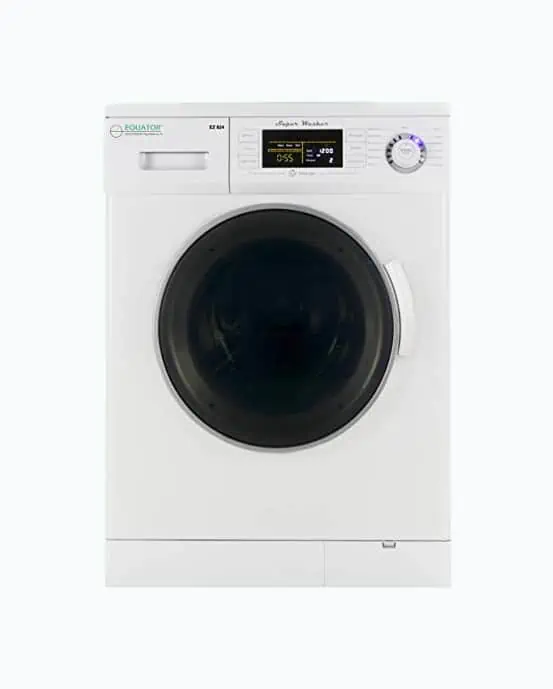 Compact washers are narrow, usually no more than 24 inches wide, but the height and depth of the compact washers can vary. This means that the capacity of the washer is limited.
Compact washers are narrow, usually no more than 24 inches wide, but the height and depth of the compact washers can vary. This means that the capacity of the washer is limited.
Compact washers can be stacked to save floor space, but matching a compact washer with a gas dryer is not an option. There are only compact electric dryers available.
Most compact washers are front loaders. They’re small and expensive machines. The cycle times tend to be longer especially if your dryer doesn’t have a vent.
Stackable Washer-Dryers
Stackable washer-dryers are stand-alone machines that can be installed on top of each other. You will need to make sure that they’re compatible first to ensure that they will safely stack without falling.
This allows you to free up space in your laundry room as they’re much easier to squeeze in anywhere with a smaller footprint. However, the stackable washer-dryers have limited capacities so they won’t hold as much washing as the bigger machines.
Top Load Washers
Top load washing machines are the classic washer design with a door in the top panel. Most top load washing machines use a cylindrical agitator in the center of the tub.
High Efficiency (HE) top load washers have an impeller for a gentler and more efficient wash, although you can now find HE top load washers with either an agitator or an impeller.
Agitator
The top load washing machine with an agitator is a basic design that’s been around for decades. It’s not the most efficient washing machine but it is fast. Most wash cycles average around 35-65 minutes.
The agitator can be rougher on your clothes, noisier than a front load machine, and may not clean heavily soiled items as well. You won’t need to worry about vibration though.
The top load washing machine with an agitator usually doesn’t remove as much moisture from the clothing during the spin cycle, so the drying time is often longer.
The traditional top load washing machine with an agitator tends to be less expensive.
Impeller
The top load washing machine with an impeller is a newer design than one with an agitator. The impeller works by rubbing the clothing against each other to clean them. This results in a deeper clean that’s almost as effective as a front load washing machine.
The impeller is also gentler on clothing than a machine with an agitator. However, you’ll find that the wash cycles are longer and last between 60-80 minutes because of the low water levels.
A top load washing machine with an impeller will remove most of the moisture from the clothing which will decrease the time needed in the dryer. These machines are quieter than a top load washer with an agitator and don’t vibrate like a front load machine.
The low water levels, long wash times, and quick movement of the impeller may cause your laundry to tangle. These machines can also become unbalanced especially if you’re washing waterproof items.
High-Efficiency Washers
High-efficiency washing machines use less water and electricity to wash your clothing. Most new machines are high-efficiency machines.
You will need to use a specialized detergent in a high-efficiency washing machine to prevent excessive suds from damaging your machine. Sometimes an extra rinse is needed during the wash cycle to make sure that all the residue from the detergent is removed.
You will need to plan more time for maintenance and cleaning your washer because it uses less water. The dirt and detergent residue may not be flushed away during the rinse cycle.
Integrated Washers
An integrated washing machine will fit between your kitchen cabinets and are designed to have a cabinet door in front of them. This allows the machine to blend into the rest of the kitchen cabinets so it looks like a normal cupboard.
The bottom and legs are set back to allow a supporting board to run along the base in front of the machine. The machine is designed to have room at the back for pipes and hoses and to fit inline with the cabinets. When you close your cabinet door, no one will know there’s a washing machine in your kitchen.
The integrated washers are slightly thinner, shorter, and shallower than a freestanding machine so they will have smaller load sizes than other washers. There are not many integrated machines available so you won’t have a large selection to choose from.
Commercial Washers
Commercial washing machines are designed to withstand heavy commercial use. They have a higher price tag than a personal machine and often come with a longer warranty as well.
Semi-Automatic Washers
Semi-automatic washing machines have twin tubs, a washtub, and a rinse / dry tub. Each tub is designed to support a specific task. So the washtub is where you fill the clothing with water and add detergent. When it’s complete, you manually move the clothing into the rinse tub for the rinse and drying cycle.
The semi-automatic machine will use less water than a fully automatic washing machine, but it’s not as efficient at cleaning clothing. It also takes up more space than a fully automatic washing machine.
Fully Automatic Washers
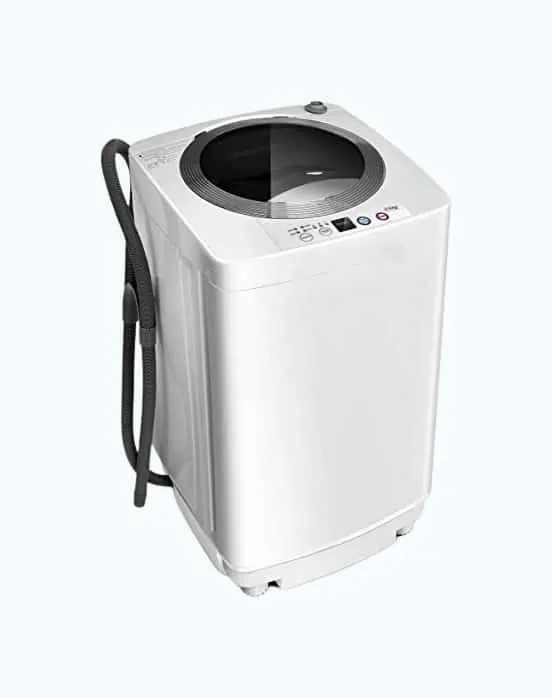 The fully automatic washing machines have only one tub. You add the laundry and then remove it when the wash cycle is completed. This way you don’t need to worry about which one does the washing and which one does the drying.
The fully automatic washing machines have only one tub. You add the laundry and then remove it when the wash cycle is completed. This way you don’t need to worry about which one does the washing and which one does the drying.
The stages are automatically completed to give you the perfect wash. However, it will use more energy than a semi-automatic washing machine.
Pros and Cons of Front Loader Vs Top Loader Washers
Front-load washing machines use less water and electricity while they clean your clothing. They also tend to be better at removing heavy stains and are gentler on your clothing. They may vibrate if the load becomes unbalanced and are likely to have more trouble with mold and mildew.
A top load washing machine allows you to fill the drum with more water to give your clothing a deeper soak. The top load washer has a faster wash cycle than a front load washer. However, it may not remove as much moisture from your laundry which will require a longer time in the dryer in order to dry your clothing.
Additional Washing Machine Features
When you’re looking for a washing machine, there are a few features you may wish to make sure that your new machine includes. Here’s a list of some popular washing machine features to consider.
Capacity
One of the first features you’ll want to consider when you’re looking for a new washing machine is what type of capacity it has. If you have a large household that includes more than 5 people, you will need a larger capacity washer that has more than 4.5 cu ft of capacity.
A small household of one or two people will only need a small washing machine that has less than 3 cu ft of capacity.
Stainless Steel Tub
There are three main types of tubs available for washing machines. You’ll find enamel drums, plastic drums, and stainless steel drums.
The enamel drums are porcelain-coated steel drums. They hold up well until the enamel chips due to zippers or metal buttons. At this point, the steel inside the drum may begin to rust.
Plastic drums are more durable, but after exposure to high temperatures, they may warp. They may become stained or develop snags that could damage your clothing.
Stainless steel tubs are considered the best type of drum. They will not rust and are scratch-resistant so they won’t develop any snags or rough spots.
Automatic Dispensers
Automatic dispensers will release a measured amount of detergent, bleach, or fabric softener at the ideal time during the cycle so you don’t need to stand over your machine in order to add it at the right time. Some automatic dispensers will hold a month’s worth of detergent simplifying the laundry process.
Automatic Load Sensing
The automatic load sensing feature allows your washing machine to sense the size of the load in the machine. It will then automatically fill the drum with the right amount of water. This feature saves you countless hours of staring at the laundry in your washing machine wondering what size of load you should use in order to wash your clothing.
Automatic Temperature Control
The automatic temperature control will make sure that your water is at the correct temperature, not too hot and not too cold. If the water coming into the tub isn’t the correct temperature, then the washing machine will adjust the proportions of the hot and cold water until the wash water is at the right temperature.
This is a useful feature if the cold water tap becomes frigid during the winter months.
Controls
Digital controls and displays allow you to program cycle settings. This way you can program your favorite settings into the machine so all you need to do is push a button to start.
If you’d like a simpler process or a machine that doesn’t need programming, you can choose a machine with a dial or push buttons.
Extra Rinse
The extra rinse cycle allows you to wash away the excess detergent. This is useful if you discover detergent residue on your clothing or if someone in your household is sensitive to detergents or fragrances. You’ll be able to use the extra rinse to make sure that your clothing is detergent-free.
Smart Phone Functions
The smart phone functions allow you to control, monitor, and adjust your wash cycles from a mobile device. It will also send you a message if the load becomes unbalanced or when the wash cycle is finished.
What Size Washer Do I Need?
A typical family of 4 will need a standard drum with dimensions around 3-4.5 cu ft. This size of drum will hold 12-16 pounds of laundry. If you have a small household with only one or two people, look for a small drum of 1-3 cu ft.
A large household that has 6 or more people in it will need a large drum of 4.5-6 cu ft with the ability to wash 20 or more pounds of laundry.
Most Reliable Washing Machine Brands
Whirlpool, Samsung, and LG tend to be top rated and reliable washing machine brands. They tend to require fewer service calls than other brands (1).
What is the Average Life of a Washing Machine?
The average lifespan of a washing machine is usually around 10 – 11 years.
Different Types of Dryers
It’s common to pick up washers and dryers at the same time when you’re looking for a new washing machine. Here are a few different types of dryers for you to consider purchasing.
Gas Dryers
A gas dryer uses natural gas or propane to produce the heat and electricity needed to power a dryer, unlike an electric dryer that uses electricity.
Vented Dryers
A vented dryer uses gas combustion or an electric heating element to heat the air. The warmed air is sent into the tumbler where it blows around the clothing. The moist air is then expelled by an exterior vent.
A ventless dryer does not use a vent as the hot air is recycled.
Condenser Dryers
A condenser dryer is a ventless dryer system. The air is heated by the condenser. The warm air then enters the tumbler to remove moisture from the clothing before returning to the condenser.
In the condenser, the hot, moist air is cooled down and reheated. The water vapor condenses and drains through a tub to be collected in a container. The container will need to be emptied manually.
The reheated dry air is then recirculated through the tumbler again. The condenser dryers are slightly more energy-efficient than standard vented dryers as it reuses the same air.
It’s also easier on your clothing since the machine runs cooler than a vented model which prevents your clothing from being overdried.
